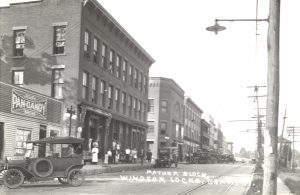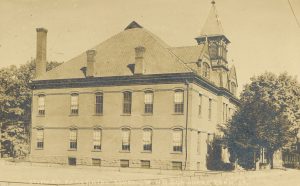 A few weeks ago, I went to one of the regular postcard shows that I frequent in the summer and came across a postcard that fills in a missing image in my family history. My entire postcard collection consists of images from Windsor Locks, Connecticut, where my Italian ancestors settled and lived for multiple generations. I have many of the mass-produced ones as well as some real photo postcards that show the flooding of the Connecticut River in 1936 and others showing houses that no longer stand.
A few weeks ago, I went to one of the regular postcard shows that I frequent in the summer and came across a postcard that fills in a missing image in my family history. My entire postcard collection consists of images from Windsor Locks, Connecticut, where my Italian ancestors settled and lived for multiple generations. I have many of the mass-produced ones as well as some real photo postcards that show the flooding of the Connecticut River in 1936 and others showing houses that no longer stand.
By the time I went to this show, I did not have any expectations about finding any new cards to add to my collection. On a whim, I decided to check the cards from Enfield, as my Scottish ancestors had settled there before moving to Ludlow. As I was flipping through all of the various views of the carpet mills in the Thompsonville section of Enfield, I paused for a second on a card that appeared out of place. Before examining the picture more closely, I could tell that it was from the 1970s, based on the color of the image and the architecture of the building, and it seemed vaguely familiar.
Upon closer examination, I discovered that it was a postcard of my grandfather’s business. I have pictures from the ribbon cutting, but this postcard is the only clear image of the entire building that I have. I told another collector, and learned that he has a real photo postcard with his grandfather with his military unit at a parade in his collection, and is hoping to find one with a better image of him. He has no idea if the card he is looking for even exists, but the nature of real photo postcards means that it could.

A real photo postcard differs from other postcards in the way that it is manufactured. Rather than being made from prints of an image, the card is a photograph that is developed on paper that can be mailed. In the early 1900s, a local amateur who enjoyed taking photographs of family, friends, or the events in their town – as well as professional photographers – could go around making postcards to use and sell. I began looking at my real photo postcards and found that I had one published by the Eastern Illustrating and Publishing Company.
Further searches revealed that in 1907, R. Herman Cassens founded the company in Maine with the goal of “Photographing the Transcontinental Trail–Maine to California” for postcards. While he was unable to reach his initial goal, he and his photographers did take more than 40,000 photographs to use as postcards between 1907 and 1947 of various scenes in New England and New York.[1]
Because of how relatively easy it was to create a real photo postcard, there could be images of your ancestor on a dusty shelf or filed away in a postcard dealer’s stock and you would not even know it. If you are looking to add more visual content to your genealogy by including images, postcards are well worth the effort to obtain. You may even find one that depicts a major aspect of an ancestor’s life.
Currently the Penobscot Marine Museum houses a bulk of the negatives that the Eastern Illustrating and Publishing Company produced and the staff are actively acquiring additional negatives as they become aware of them. Because the goal was to focus on small towns, some of these images are unique snapshots of rural New England that only exist because of the Eastern Illustrating and Publishing Company.
A list of towns that the Museum has can be found here: http://penobscotmarinemuseum.org/eastern-illustrating-publishing-company/
and information about how to help the museum acquire additional negatives can be found here:
http://penobscotmarinemuseum.org/help-us-grow-the-photography-collection/
Note
[1] See http://penobscotmarinemuseum.org/eastern-illustrating-publishing-company/
I am a post card collector as well. I have many whom I am clueless as to whom they r, but I am really looking at them closely because of names, dates addresses, & the picture. Even if nothing is on them but a picture, it’s still important. This helpful information. Thank u.
My wife’s Scottish ancestors, the Hoods and the Anguses, came to Thompsonville (Enfield), CT; from Kilmarnock in 1828 to build and then work in the carpet mills. I have never seen any post cards of the mills, but then I’ve never looked.
The Enfield Historical Society has a good article about the carpet industry in Thompsonville,(a section of Enfield). What was once the Bigelow Carpet Co closed in the 1970s and has been turned into apartments. EJ
Thanks for your reference. Many years ago my wife and I visited Thompsonville and saw the “remains” of the carpet mills, as well as Scotch Row, the housing that had been built by and for workers. Years later, we visited again; this time we were astonished to see Bigelow Commons and had a chance to look at the apartments of that development. Nice job at preserving what they could of the mills’ heritage.
I love postcards! I inherited a stack of them from my mother and, initially, I wasn’t sure who had bought them/owned them or written them (I do think they date to early 1900s). I now think that my grandfather traveled all over the country as a young man and these are really fascinating. There is also a postcard with my grandmother’s image – not sure what the occasion would have been. I am anxious to check your link because I’ve ancestors from Maine.
I want to thank you for describing the process that produced these photographs. I inherited a collection of photographs from both my maternal and paternal sides of the family and among them are what I now know are real photo postcards. I’ve wondered about them and how they were produced or obtained, but I had not done any research to satisfy my curiosity. The ones I have are mostly of people who lived in Kentucky, Indiana and Illinois, so I’m guessing this process was popular in areas other than New England.
Thank you for the short history of real photo postcards. I have one from the Salina KS area of my paternal grandmother dressed in her Sunday best, standing behind my father as a child in his best, with the scene completed by Daddy’s next youngest brother sitting up in a wicker baby carriage. The card was obviously a way for Grandma to distribute the latest photo of herself and her sons to out-of-town relatives without putting the photo into an envelope at a higher rate of postage. On the back of the card is a message to her parents in Lindsborg written in Swedish, as they first settled in a Swedish neighborhood in Chicago and then moved to predominately-Swedish Lindsborg KS, and therefore never bothered to learn English. I would be an adult before it dawned that my dad had grown up speaking English as well as Swedish, most of which he’d forgotten in later life except for few phrases with which to taunt my English-only mother when the mood struck. Only a tiny part of the message on the back of the card, btw, has yielded to translation. Something about Grandma finally got the prints of the photos “and here it is”. The rest is apparently in a regional dialect unknown to people not native to that part of Sweden.
I love Post Cards, have collections of my maternal Grandparents memorabilia and a few from my Dad’s side as well. They used them to send messages too, so double the information. One especially I value is a photo of a 2nd Great Grandmother to me. She was the maternal Grandmother of my Grandfather, it was sent to him as a Birthday card and his sister wrote on it who the person is in the picture. Otherwise of course I would have no idea who she might be. Others from my husband’s side, found one congratulating his Grandmother on the birth of his Mother. It was sent from his Grandmother’s Grandmother, the post mark is huge and tells me where they were living at the time. That one is in pencil, have scanned many of them to enhance and have shared among family.
Great article Jason. As the archivist for the Eastern Illustrating Collection at the Penobscot Marine Museum I am especially pleased. For those interested in exploring the collection, you can see what we have catalogued in our online database: http://penobscotmarinemuseum.pastperfectonline.com/
Also, I just co-authored a book on Eastern Illustrating: https://www.amazon.com/Maine-Glass-Twentieth-Century-Photography/dp/0884483789
Lastly, a documentary film is being made about Eastern as well: http://sumnermckane.com/index.php?/store/northeast-by-eastern/
It’s been two weeks since this post, but, I can’t help sharing a “serendipity” moment regarding local postcards. And one tip for those of you searching for ones that might be important to you.
I was a librarian in my town library and was looking for display items for the section of town where my branch library was located. While at a meeting in the main branch, I stopped by the reference section where a friend, and one of the longest serving reference librarians, had her desk. I explained what I was looking for, perhaps some old pictures of our town. She replied brightly, “Oh funny you should ask, I just had someone drop in with a packet of postcards he thought the library should have for safekeeping. He said he found them in the attic of a house he was thinking of buying and they were in a discard box.” She picked up a package and gave it to me. “Take what you want for your display,”
Well, my dears, the incredible happened. Before my very eyes, among others, were three postcards of our town and in the message section, in juvenile handwriting, were notes written by my own father when he was eight years old! It seems he was ill and had to go to the seashore to recover and was out of school for quite a while. His postcards were written to his school friends and his teacher telling them how he was feeling and that he missed them!
What a find!
My research librarian friend, allowed me to take them home with me, needless to say! Not only one serendipitous event— the finding of the cards; but the delivering them to the library; and then me coming along the same day and asking the one person in the whole building who would know about them. Three serendipities in a row!!
So, you may want to check with your local library to see if they may be holding postcards in their collection. Now, with scanning, you may be able to find and take home some special treasures!
Absolutely wonderful story, Judith! Some towns have little shops selling antique-type things and they may carry postcards of the town/area. Visited one in Minnesota but wasn’t as lucky to find one with my relative’s name on it!
How does one contact the author or NEHGS to obtain permission to republish one paragraph of this article in a genealogy chapter newsletter?